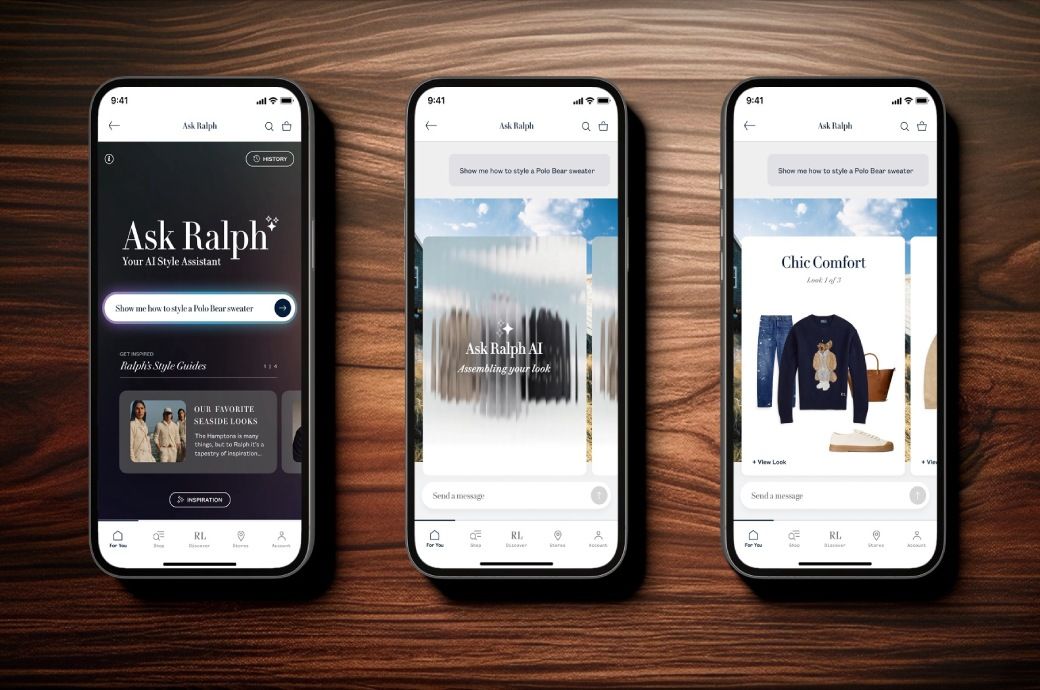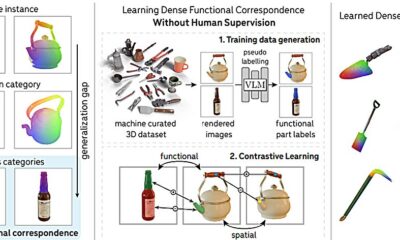Tech
Novel textile can adjust its aerodynamic properties on demand

Imagine a road cyclist or downhill skier whose clothing adapts to their wind speed, allowing them to shave time just by pulling or stretching the fabric.
Such cutting-edge textiles are within reach, thanks to researchers at the Harvard John A. Paulson School of Engineering and Applied Sciences (SEAS). Led by SEAS mechanical engineering graduate student David Farrell, a study published in Advanced Materials describes a new type of textile that uses dimpling to adjust its aerodynamic properties while worn on the body. The research has the potential to change not only high-speed sports, but also industries like aerospace, maritime, and civil engineering.
The research is a collaboration between the labs of Katia Bertoldi, the William and Ami Kuan Danoff Professor of Applied Mechanics, and Conor J. Walsh, the Paul A. Maeder Professor of Engineering and Applied Sciences.
On-demand golf ball dimples
Farrell, whose research interests lie at the intersection of fluid dynamics and artificially engineered materials, or metamaterials, led to the creation of a unique textile that forms dimples on its surface when stretched, even when tightly fitted around a person’s body. The fabrics utilize the same aerodynamic principles as a golf ball, whose dimpled surface causes a ball to fly farther by using turbulence to reduce drag. Because the fabric is soft and elastic, it can move and stretch to change the size and shape of the dimples on demand.
Adjusting dimple sizes can make the fabric perform better in certain wind speeds by reducing drag by up to 20%, according to the researchers’ experiments using a wind tunnel.
“By performing 3,000 simulations, we were able to explore thousands of dimpling patterns,” Farrell said. “We were able to tune how big the dimple is, as well as its form. When we put these patterns back in the wind tunnel, we find that certain patterns and dimples are optimized for specific wind-speed regions.”
Farrell and team used a laser cutter and heat press to create a dual-toned fabric made of a stiffer black woven material, similar to a backpack strap, and a gray, softer knit that’s flexible and comfortable. Using a two-step manufacturing process, they cut patterns into the woven fabric and sealed it together with the knit layer to form a textile composite. Experimenting with multiple flat samples patterned in lattices like squares and hexagons, they systematically explored how different tessellations affect the mechanical response of each textile material.
Lattice pattern
The textile composite’s on-demand dimpling is the result of a lattice pattern that Bertoldi and others have previously explored for its unusual properties. Stretch a traditional textile onto the body, and it will smooth out and tighten. “Our textile composite breaks that rule,” Farrell explained. “The unique lattice pattern allows the textile to expand around the arm rather than clamp down.
“We’re using this unique property that [Bertoldi] and others have explored for the last 10 years in metamaterials, and we’re putting it into wearables in a way that no one’s really seen before,” Farrell said.
More information:
David T. Farrell et al, Programmable Surface Dimpling of Textile Metamaterials for Aerodynamic Control, Advanced Materials (2025). DOI: 10.1002/adma.202505817
Citation:
Novel textile can adjust its aerodynamic properties on demand (2025, October 28)
retrieved 28 October 2025
from https://techxplore.com/news/2025-10-textile-adjust-aerodynamic-properties-demand.html
This document is subject to copyright. Apart from any fair dealing for the purpose of private study or research, no
part may be reproduced without the written permission. The content is provided for information purposes only.
Tech
Top NordVPN Coupons: 77% Off, Plus 3 Months Free

Whether you’re worried about the open network at your local coffee shop or want to get around geo-restrictions when you’re traveling, NordVPN can help. A virtual private network (VPN) is like a protective tunnel, keeping your data safe from prying eyes. VPNs aren’t perfect protection (you need to trust your VPN provider), but they’re always going to be better than nothing when you’re using a public hotspot. They also make it easy to continue to watch your favorite shows even when you’re on vacation. If you want to learn more about how to protect yourself online, see our guide to The Best VPNs.
Get 77% Off Plans With Exclusive NordVPN Discount Code
NordVPN is pretty much always having a sale, but some of the deals are better than others and this is one of the best we’ve seen. Right now, NordVPN is offering 77% off its regular price, plus an Amazon gift card valued up to $50 when you sign up for a 2-year Prime plan. It’s valid for the first 15 months of the subscription, with threat protection, high-speed VPN, and more. Follow the link above and use our exclusive coupon code at checkout to get the deal.
Save More With a NordVPN Subscription Plan
The two-year Plus plan is the most popular, and our recommendation. For a limited time, their more comprehensive Prime 2-year subscriptions qualify for up to 77% off, and you’ll receive 3 free months with select 2-year plans, starting with the Plus option.
NordVPN offers different plans for different needs, including one-year and one-month plans. Plans’ pricing varies greatly, with short-term, one-month plans starting at $13. The plans get cheaper the longer you commit to a plan, to reward loyal VPN customers. One-year plans start at $5 and go to $10, depending on which package you choose. Two-year plans are even cheaper, starting at $3 and going up to $7 for the top-tier plans with all of the bells and whistles. It makes a lot more sense to invest in a longer protection plan to keep your information and devices safe, for less.
Score a NordVPN Discount Code for 15% Off
The coupons aren’t the only deals to be had. You can wait for a sale (see above) or if you qualify, there are discounts for students, graduates, teachers, healthcare, military, and first responders. Once verified with Student Beans, you can unlock a NordVPN promo code for 15% off plans.
NordVPN Friend Referral Discount
If you like NordVPN, you can save yourself even more with the refer-a-friend promotion. You’ll receive 3 months free for every friend who buys NordVPN through your referral link. The more friends you refer, the more rewards you’ll earn. Your friends will get the same deal you did, 3 extra months if they choose the 1- or 2-year plans or 1 free month if they opt for the monthly plan.
Get the latest NordVPN Plans in 2025
NordVPN has four tiers of plans fit for every type of need. Each gets you a secure VPN, but with each level you’ll get even more perks, like an ad tracker and blocker and 1 TB of Cloud storage. Right now, you can get up to 77% off each plan, including three months free. Check out which plan (and price) is the best fit for you here.
Tech
US Ralph Lauren partners with Microsoft for AI shopping experience

Continuing a decades-long partnership, Ask Ralph was developed with Microsoft on its Azure OpenAI platform and uses advanced conversational AI technology and natural language processing to understand open-ended prompts, interpret context and provide tailored recommendations to closely mimic the experience of speaking with an in-store stylist.
Ralph Lauren has launched Ask Ralph, an AI-powered conversational shopping tool built with Microsoft on Azure OpenAI.
The feature offers personalised, shoppable Polo Ralph Lauren outfits in response to user prompts, simulating an in-store stylist experience.
Available first to US app users, it provides styling inspiration and tailored recommendations to enhance discovery and brand engagement.
“Twenty-five years ago, we partnered with Microsoft to launch one of the fashion industry’s first e-commerce platforms, and today, we are once again redefining the shopping experience for the next generation,” said David Lauren, Chief Branding and Innovation Officer, Ralph Lauren Corporation. “Whether getting ready for a first day of a new job, or creating the perfect look for a night out, Ask Ralph is about more than just discovery – it is about engaging consumers with what they love most about Ralph Lauren: our iconic, unique take on style, providing timeless head-to-toe looks that inspire them to step into our world.”
Shoppers can interact with Ask Ralph just as they would with a stylist in a Ralph Lauren store, through simple, conversational prompts. From “What should I wear to a concert?” to “Show me some women’s Polo Bear sweaters,” or styling queries like, “How can I style my navy-blue men’s blazer?” Ask Ralph responds, surfacing visually laid out, complete Polo Ralph Lauren looks with styling tips, integrating content from across Ralph Lauren’s digital channels. Users can ask clarifying questions and refine the recommendations to align with their own sense of style. Ask Ralph makes it easy to add individual elements of a look to shopping carts or purchase the head-to-toe recommendation.
“AI is transforming the way consumers get inspired, educated and purchase from fashion brands around the world,” said Shelley Bransten, Corporate Vice President of Global Industry Solutions, Microsoft. “We’re proud to bring the combination of our trusted generative AI capabilities through Azure OpenAI together with Ralph Lauren’s iconic brand to pave the way for an entirely new conversational commerce experience.”
Informed by how users initially use and engage with Ask Ralph, the tool will continue to develop, including releasing new features and increased personalized experiences, expanding to additional Ralph Lauren brands and launching across more platforms in markets around the world.
Ask Ralph is the latest milestone in Ralph Lauren’s rich history of innovation and in leading the industry in creating immersive and cinematic retail experiences that transport consumers into the World of Ralph Lauren. Twenty-five years ago, the Company was one of the first luxury brands to pioneer e-commerce, setting a new industry standard. Always pushing boundaries to surprise, delight and inspire consumers, the Company has long experimented with cutting-edge ideas that were years ahead of their time – from interactive and virtual shopping technology to holograms, 4D projections and CGI animations.
The Company also continues to invest in AI and other technologies to enhance the consumer experience, like more personalized marketing and engaging digital experiences, as well as to optimize its operations, including predictive inventory management and product demand forecasting.
Note: The headline, insights, and image of this press release may have been refined by the Fibre2Fashion staff; the rest of the content remains unchanged.
Fibre2Fashion News Desk (RM)
Tech
AI chatbots are becoming everyday tools for mundane tasks, use data shows

Artificial intelligence is fast becoming “part of the furniture.” A decade after IBM’s Watson triumphed on “Jeopardy!,” generative AI models are in kitchens and home offices. People often talk about AI in science fiction terms, yet the most consequential change in 2025 may be its banal ubiquity.
To appreciate how ordinary AI use has become, it helps to remember that this trend didn’t start with generative chatbots. A 2017 Knowledge at Wharton newsletter documented how deep learning algorithms were already powering chatbots on social media and photo apps’ facial recognition functions. Digital assistants such as Siri and Alexa were performing everyday tasks, and AI-powered image generators could create images that fooled 40% of viewers.
When ChatGPT became publicly available on Nov. 30, 2022, the shift felt sudden, but it was built on years of incremental integration. AI’s presence is now so mundane that people consult chatbots for recipes, use them as study partners and rely on them for administrative chores.
As a writer and professor who studies ways that generative AI can be an everyday collaborator, I find that recent usage reports show how AI has been woven into everyday life. (Full disclosure: I am a member of OpenAI’s Educator Council, an uncompensated group of higher education faculty who provide feedback to OpenAI on educational use cases.)
Who’s using ChatGPT and why?
Economists at OpenAI and Harvard analyzed 1.5 million ChatGPT conversations from November 2022 through July 2025. Their findings show that adoption has broadened beyond early users: It’s being used all over the world, among all types of people. Adoption has grown fastest in low- and middle-income countries, and growth rates in the lowest-income countries are now more than four times those in the richest nations.
Most interactions revolve around mundane activities. Three-quarters of conversations involve practical guidance, information seeking and writing. These categories are for activities such as getting advice on how to cook an unusual type of food, where to find the nearest pharmacy, and getting feedback on email drafts. More than 70% of ChatGPT use is for nonwork tasks, demonstrating AI’s role in people’s personal lives. The economists found that 73% of messages were not related to work as of June 2025, up from 53% in June 2024.
Claude and the geography of adoption
Anthropic’s economic index paints a similar picture of uneven AI adoption. Researchers at the company tracked users’ conversations with the company’s Claude AI chatbot relative to the working-age population. The data shows sharp contrasts between nations. Singapore’s per-capita use is 4.6 times higher than expected based on its population size, and Canada’s is 2.9 times higher. India and Nigeria, meanwhile, use Claude at only a quarter of predicted levels.
In the United States, use reflects local economies, with activity tied to regional strengths: tech in California, finance in Florida and documentation in D.C. In lower-use countries, more than half of Claude’s activity involves programming. In higher-use countries, people apply it across education, science and business. High-use countries favor humans working iteratively with AI, such as refining text, while low-use countries rely more on delegating full tasks, such as finding information.
It’s important to note that OpenAI reports between 400 million and 700 million weekly active users in 2025, while third-party analytics estimate Claude at roughly 30 million monthly active users during a similar time period. For comparison, Gemini had approximately 350 million monthly active users and Microsoft reported in July 2025 more than 100 million monthly active users for its Copilot apps. Perplexity’s CEO reported in an interview that the company’s language AI has a “user base of over 30 million active users.”
While these metrics are from a similar time period, mid-2025, it’s important to note the differences in reporting and metrics, particularly weekly versus monthly active users. By any measure, though, ChatGPT’s user base is by far the largest, making it a commonly used generative AI tool for everyday tasks.
Everyday tool
So, what do mundane uses of AI look like at home? Consider these scenarios:
- Meal planning and recipes: A parent asks ChatGPT for vegan meal ideas that use leftover kale and mushrooms, saving time and reducing waste.
- Personal finance: ChatGPT drafts a budget, suggests savings strategies or explains the fine print of a credit card offer, translating legalese into plain language.
- Writing support: Neurodivergent writers use ChatGPT to organize ideas and scaffold drafts. A writer with ADHD can upload notes and ask the model to group them into themes, then expand each into a paragraph while keeping the writer’s tone and reasoning. This helps reduce cognitive overload and supports focus, while the writer retains their own voice.
These scenarios illustrate that AI can help with mundane decisions, act as a sounding board and support creativity. The help with mundane tasks can be a big lift: By handling routine planning and information retrieval, AI frees people to focus on empathy, judgment and reflection.
From extraordinary to ordinary tool
AI has transitioned from a futuristic curiosity to an everyday co-pilot, with voice assistants and generative models helping people write, cook and plan.
Inviting AI to our kitchen tables not as a mysterious oracle but as a helpful assistant means cultivating AI literacy and learning prompting techniques. It means recognizing AI’s strengths, mitigating its risks and shaping a future where intelligence—human and artificial—works for everyone.
This article is republished from The Conversation under a Creative Commons license. Read the original article.![]()
Citation:
AI chatbots are becoming everyday tools for mundane tasks, use data shows (2025, October 28)
retrieved 28 October 2025
from https://techxplore.com/news/2025-10-ai-chatbots-everyday-tools-mundane.html
This document is subject to copyright. Apart from any fair dealing for the purpose of private study or research, no
part may be reproduced without the written permission. The content is provided for information purposes only.
-

 Fashion1 week ago
Fashion1 week agoChinese woman charged over gold theft at Paris Natural History Museum
-

 Entertainment1 week ago
Entertainment1 week agoJohn Grisham unveils his first-ever mystery, “The Widow”
-

 Tech1 week ago
Tech1 week agoThis Smart Warming Mug Is Marked Down by $60
-

 Fashion1 week ago
Fashion1 week agoeBay UK seller fee removal sends revenue down but profits rise
-

 Tech1 week ago
Tech1 week agoEaster Island’s Moai Statues May Have Walked to Where They Now Stand
-

 Tech1 week ago
Tech1 week agoOpenAI has slipped shopping into ChatGPT users’ chats—here’s why that matters
-

 Tech1 week ago
Tech1 week agoAI model could boost robot intelligence via object recognition
-

 Fashion1 week ago
Fashion1 week agoThe North Face and Cecilie Bahnsen launch second collaboration


















